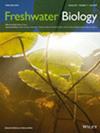反映真实群落生物多样性格局需要多种多样性测度
IF 2.8
2区 生物学
Q2 ECOLOGY
引用次数: 0
摘要
多样性测量之间关系的不同强度——无论是分类学的、功能的还是系统发育的——意味着生物多样性的维度是可变的。了解这些方面对于辨别当地社区如何应对环境变化至关重要。本研究旨在(i)评估生态系统中生物多样性的维度,(ii)确定区分地方群落的主要措施,(iii)验证生物多样性维度与环境维度正相关的假设。我使用了一个大型数据集,包括来自美国各地湖泊生态系统的浮游植物、浮游动物和大型无脊椎动物群落,基于主成分分析(PCA)的特征值计算了Camargo的均匀指数,以评估生物多样性的维度。我还评估了多重生物多样性维度对描述群落模式的必要性。我发现,要充分捕捉浮游生物和大型无脊椎动物群落的生物多样性模式,分别需要两到三套多样性措施。区分地方群落的主要指标是类群间的系统发育结构。分类和功能丰富度也成为重要的变量。大型无脊椎动物群落的生物多样性维度与环境维度之间存在正相关关系,而浮游生物群落则不存在正相关关系。这一发现表明,环境复杂性可能会对不同的群落结构和分类群体产生不同的影响。这些研究结果间接表明,依赖单一测量可能导致研究忽视生物多样性对环境梯度的重要响应。更重要的是,与之前的研究一致,我发现仅使用基于分类身份的测量方法在区分真实群落方面存在不足。在现实环境(如生物评价)中使用需要详细信息(如系统发育结构)的措施的可行性是一个应该在进一步研究中仔细评估的问题。本文章由计算机程序翻译,如有差异,请以英文原文为准。
Multiple Diversity Measures Are Necessary to Represent Biodiversity Patterns of Lentic Communities
- The varying strengths of relationships between diversity measures—be they taxonomic, functional or phylogenetic—imply that biodiversity dimensionality is variable. Understanding these dimensions is essential to discerning how local communities respond to environmental changes.
- This study aimed to (i) evaluate the dimensionality of biodiversity in lentic systems, (ii) identify the primary measures that differentiate local communities and (iii) test the hypothesis that biodiversity dimensionality is positively correlated with environmental dimensionality.
- Using a large dataset encompassing phytoplankton, zooplankton and macroinvertebrate communities from lake ecosystems across the contiguous United States, I calculated Camargo's evenness index based on the eigenvalues from a principal component analysis (PCA) to assess the dimensionality of biodiversity. I also evaluated the degree to which multiple biodiversity dimensions were necessary to describe community patterns.
- I found that two to three sets of diversity measures were required to adequately capture the biodiversity patterns of plankton and macroinvertebrate communities, respectively. The main measures differentiating local communities were those that included the phylogenetic structure among the taxa. Taxonomic and functional richness also emerged as important variables.
- The anticipated positive relationship between biodiversity dimensionality and environmental dimensionality was supported for macroinvertebrate communities but not for planktonic groups. This finding suggests that environmental complexity may have distinct impacts depending on the community structure and taxonomic group considered.
- These study results indirectly suggest that relying on a single measure may cause studies to overlook important responses of biodiversity to environmental gradients. More importantly, in line with previous studies, I found that using only measures based on taxonomic identities falls short in differentiating lentic communities. The feasibility of using measures that require detailed information (e.g., phylogenetic structure) in real-world contexts (e.g., bioassessment) is an issue that should be carefully evaluated in further studies.
求助全文
通过发布文献求助,成功后即可免费获取论文全文。
去求助
来源期刊

Freshwater Biology
生物-海洋与淡水生物学
CiteScore
5.90
自引率
3.70%
发文量
162
审稿时长
2 months
期刊介绍:
Freshwater Biology publishes papers on all aspects of the ecology of inland waters, including rivers and lakes, ground waters, flood plains and other freshwater wetlands. We include studies of micro-organisms, algae, macrophytes, invertebrates, fish and other vertebrates, as well as those concerning whole systems and related physical and chemical aspects of the environment, provided that they have clear biological relevance.
Studies may focus at any level in the ecological hierarchy from physiological ecology and animal behaviour, through population dynamics and evolutionary genetics, to community interactions, biogeography and ecosystem functioning. They may also be at any scale: from microhabitat to landscape, and continental to global. Preference is given to research, whether meta-analytical, experimental, theoretical or descriptive, highlighting causal (ecological) mechanisms from which clearly stated hypotheses are derived. Manuscripts with an experimental or conceptual flavour are particularly welcome, as are those or which integrate laboratory and field work, and studies from less well researched areas of the world. Priority is given to submissions that are likely to interest a wide range of readers.
We encourage submission of papers well grounded in ecological theory that deal with issues related to the conservation and management of inland waters. Papers interpreting fundamental research in a way that makes clear its applied, strategic or socio-economic relevance are also welcome.
Review articles (FRESHWATER BIOLOGY REVIEWS) and discussion papers (OPINION) are also invited: these enable authors to publish high-quality material outside the constraints of standard research papers.
 求助内容:
求助内容: 应助结果提醒方式:
应助结果提醒方式:


